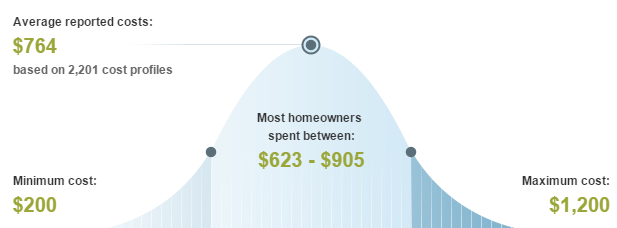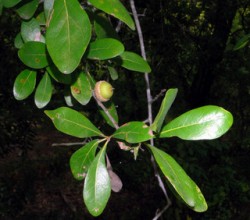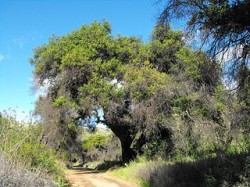Skip to a section:
- Costs – Learn more about the average costs to maintain, remove and grind trees and stumps in Gainesville, Florida.
- FAQs – Gainesville has rules and regulations regarding trees in the area, along with ones that thrive better than others. Check out the facts before you plant new ones in your yard.
- Services – Find a Gainesville arborist near you today!
How Much Do Tree Services Cost in Gainesville?
As any property owner knows, the cost in both labor and equipment when caring for trees can be substantial. Costs can depend on factors such as surrounding power lines, structures and type of trees as well as variations due to age and health of the plant life. For Gainesville, the costs of tree management services can vary widely thanks to the region’s flora diversity.

How Much Does Tree Removal Cost?
Removal of trees in Gainesville Florida can cost between $200 and $1,200. Most homeowners will spend an average of between $620 and $910.
How Much Does Stump Removal Cost?
Stump removal may seem like a simple job to the novice, but it’s actually more difficult than one might first imagine. When hiring contractors for stump removal, Gainesville residents can pay anywhere from a high of $140 for a large tree stump, to a low of $80. Costs for a medium tree stump can run from $75 to about $150. The labor per stump is estimated at about 2 hours, and the major portion of cost is equipment related.
Average Cost of Tree Maintenance in Gainesville
Maintenance and pruning are as important to the health of trees as much as they are important to the aesthetics. When tending to the maintenance needs of their yards, homeowners can expect to pay as much as $1,100, or as little as $100. Most homeowners will pay an average of $370 and $550 for trimming and pruning.
Gainesville Tree Facts & FAQs
Gainesville falls into Zone 8B and 9A according to the USDA Hardiness Zone maps. Plants in these zones are generally considered to be able to withstand lows of 15 degrees Fahrenheit to 25 degrees Fahrenheit, respectively, depending on the resiliency and health of the plant. Florida-friendly landscaping includes plants that are hardy enough to withstand tropical temperatures as well as frequent precipitation. Pest-resistant plants are also desirable because of the detrimental effect that pesticides are having on the state’s aquifers.
Tree Service Tips and Regulations
 Gainesville is a city with complex tree regulations, which are focused on saving trees, especially older “Heritage Trees.” Heritage trees are defined as any native species larger than 20 inches in diameter. Water oaks, laurel Oaks, loblolly pines, and sweetgum become Heritage trees when they are larger than 30 inches in diameter. If a tree is removed without a permit, Gainesville requires they be replaced on a diameter inch-for-inch basis with nursery grown trees 3 inches in caliper, 14 feet tall. Dead trees are exempt from the ordinances and may be removed at the homeowner’s discretion. Other rules insist that trees be replaced with comparable species. There are also rules against pruning branches that are higher than 7 feet off the ground, and over-thinning a tree’s crown.
Gainesville is a city with complex tree regulations, which are focused on saving trees, especially older “Heritage Trees.” Heritage trees are defined as any native species larger than 20 inches in diameter. Water oaks, laurel Oaks, loblolly pines, and sweetgum become Heritage trees when they are larger than 30 inches in diameter. If a tree is removed without a permit, Gainesville requires they be replaced on a diameter inch-for-inch basis with nursery grown trees 3 inches in caliper, 14 feet tall. Dead trees are exempt from the ordinances and may be removed at the homeowner’s discretion. Other rules insist that trees be replaced with comparable species. There are also rules against pruning branches that are higher than 7 feet off the ground, and over-thinning a tree’s crown.
When planting trees beneath or near power lines, the choices are legislatively limited to trees that will not grow as high as the power lines and trees that will not have branches that spread to interfere with power lines. Homeowners are responsible for researching the type of tree they buy and ensuring that it will meet these standards.
Because Gainesville is subject to the tropical storms and hurricanes, it is best to remove dead or damaged trees prior to the hurricane season. Trees should be pruned either before or after the spring growth. Hurricane season itself is not a good time to prune, so avoid doing so in the months June through November. Hurricane weather may take care of dead branches and overgrowth for you, but it may also deposit these items through your windows or roof.
It also is usually best to prune trees during their dormancy and before spring growth. As the winter months in Florida include neither snow nor particularly harsh weather, winter dormancy can be an excellent time to prune trees. Evergreen trees can be safely pruned at any time, but to promote rapid growth, pruning directly before spring growth is advised. Hickory, oak and other so-called shade trees need to be pruned while dormant.
Trees that Thrive
 Gainesville as a city is proud of its trees, and with good reason. Its canopy is characterized as dense and rich in diversity with upwards of 300 species, about 89 percent of them being native to the region.
Gainesville as a city is proud of its trees, and with good reason. Its canopy is characterized as dense and rich in diversity with upwards of 300 species, about 89 percent of them being native to the region.
Water and laurel oaks dominate the region as large trees that provide plentiful shade. Slash pine (Pinus elliottii) and live oak (Quercus geminate) make up a substantial number of the remaining trees. While the state tree of Florida is the cabbage palm (Sabal palmetto), this particular tree isn’t seen very often within the city.
There are a wide variety of fruit trees that grow in Gainesville, such as fig, banana, pear, and various citrus such as oranges and lemons. Stone fruits such as plum or cherry are more difficult to grow in the area.
The tallest tree in Gainsville is also one of the tallest trees in all of Florida: the celon oak, just north of the city. Short trees may include the gardenia and azalea.
Tree Diseases in Gainesville
The climate of Florida unfortunately allows a large variety of pestilence to thrive, and there are numerous diseases that tree enthusiasts need to keep an eye out for. Various types of cankers, root rot, and wood decay abound. Some of the other things to watch for are:
- Needle rust
- Needle cast
- Brownspot needle blight
- Pitch canker
- Fusiform rust
- Wetwood and slime flux
- Laurel wilt
Plant Hardiness Zones in Florida
Here is the Florida plant hardiness zone map, as provided by the USDA:

Image credit:
Laurel oak
Local Tree Services in Gainesville
